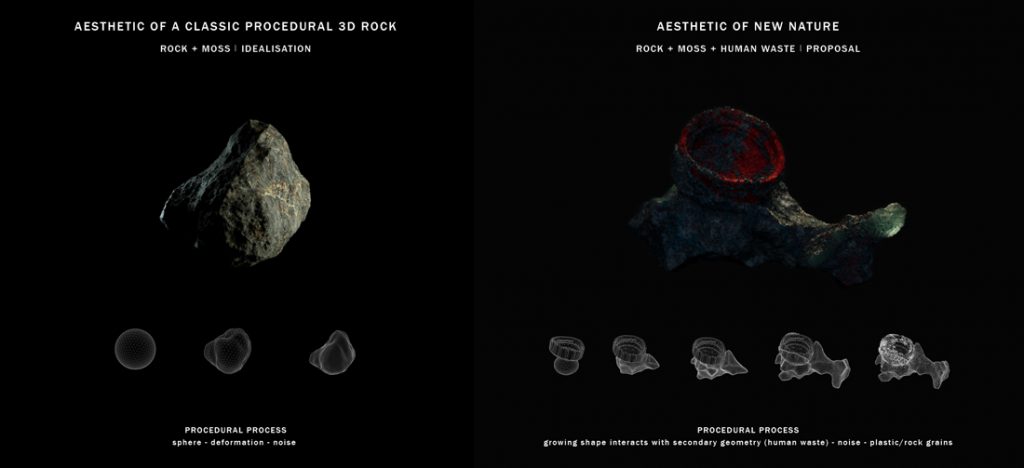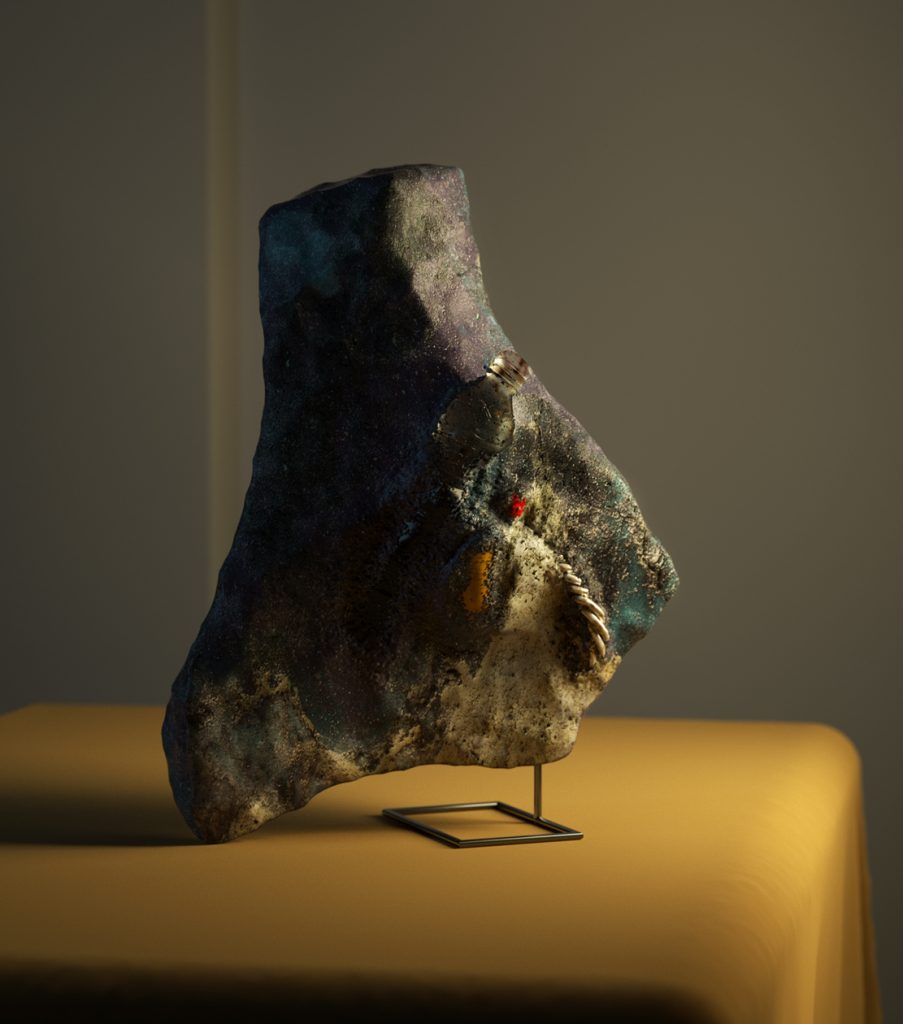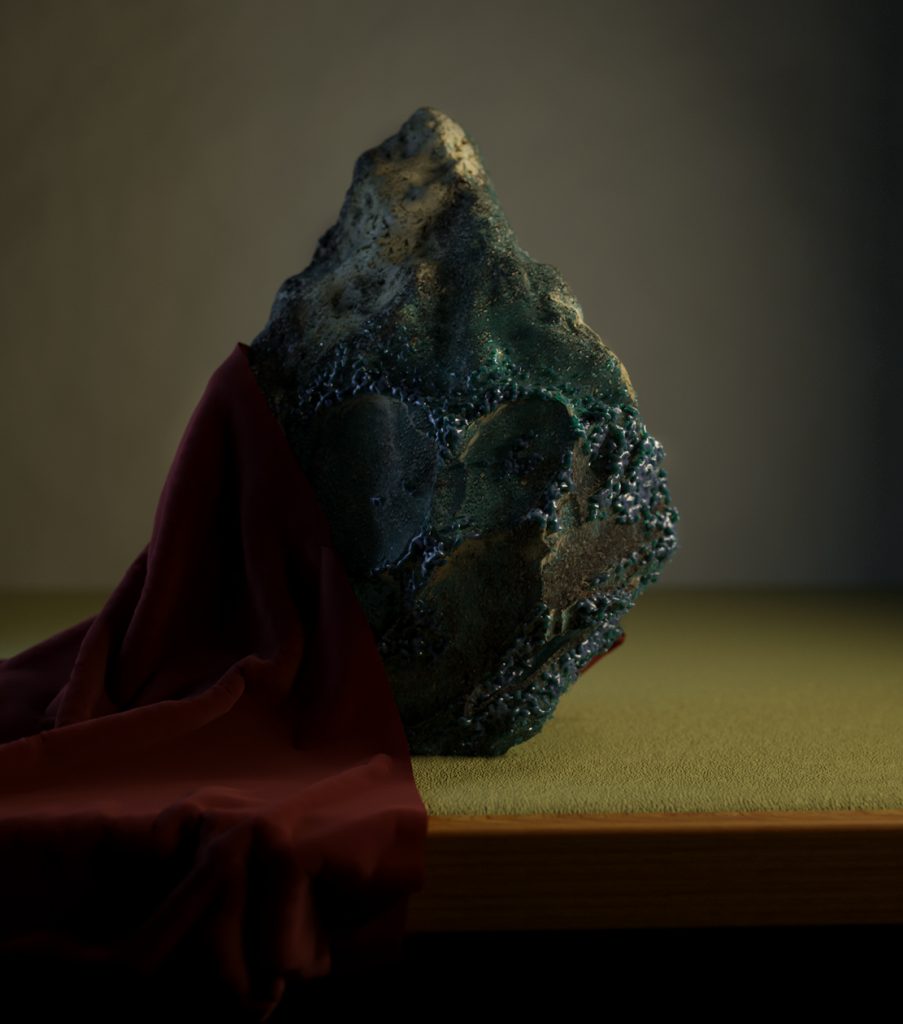Interview by Tony Cho

Davide Piscitelli’s field of interest lies in ‘objects’ of a ubiquitous nature, unbound to spatiotemporal boundaries. To put it simply, these hyperobjects are entities in the world that are like floating icebergs- viewing limited to what’s above the surface. Davide Piscitelli investigates these hyperobjects and their implications in an attempt to look under the waters to find a fast-arriving future.
In New Nature, one sees a series of rocks- seemingly found somewhere on this earth. These rocks have a peculiar quality to them, with bits and bobs off human waste emerging and embedded into the rock- a metamorphosis from sediment to plastiglomerate. These rocks look so real that, in fact, it is hard to believe that they are a product of digital rendering and procedural generation. Its texture, shadow, shape and colouring all speak to the reality of the object. However, the rock remains a rendering of an object created through a process of sculpting through code. Add to it the addition of human waste embedded in the rock. These renderings not only mirror the physical object in visual form but captures the existential state of nature the rock exists in.
New Nature is Piscitelli’s latest work which investigates the potential effects of an oncoming phygital culture. With the advent of advanced CGI, there is no longer any distinction to make between images and objects that allow us to recognise the real or digital. In turn, both physical reality and visual culture begin to intercede as aspects of physical reality begin to borrow from that of the digital.
Piscitelli shows the paradox of visual etymology when the distinction between the physical and digital spheres cannot be made. New Nature introduces this phenomenon through a series of digital rocks. However, does not mimic nature for nature’s sake but rather creates a proposition for how “nature” should be visualised. Here, human waste plays an important role in authoring the visual signature of the piece as it points not to nature’s romantic ideal but to its gritty reality.
With a wide range of interests, Davide Piscitelli bravely tackles a subject vastly different from his last work, GOGO’s Dream, choosing this time to focus on the ecological aspects of existing hyperobjects. Interested in exploring a post-anthropocentric society? For Piscitelli, there are no limits when exploring the future of our relationship with objects, intelligent systems, and the ecological frameworks that exist in society.
Unlike the lightheartedness of GOGO’s Dream, in New Nature, the tone seems to be more serious and subversive. Perhaps that is not Piscitelli’s intention but only the brutality of the subject matter itself. In all, Piscitelli’s works can be interpreted in many ways. As a harbinger for the post-anthropocentric thinking that will need to take place for our species to live comfortably in the world. Or as a dire warning for what has become of the world as we know it.


For those that are not familiar with your practice, could tell us a bit about your background and how and when did you get interested in the crossover of art and technology?
I am not sure when it started. It feels like I have always been fascinated by art and technology. Some of the technologies that are reshaping our lives, like the Internet, appeared when I was just a child. I basically grew up with them. Growing up in Italy gave me a different perspective on the importance of art in our life. In Italy, art is everywhere. It is completely embedded in our culture. Art and technology are always been in symbiosis. Their natural relationship is also part of who I am today.
Studying art for me was a way of understanding humanity, cultures and history. I like working at the intersection between arts, science and philosophy because I believe in the dialogue between these disciplines. They would not survive without each other. I use art as a lens to investigate the deep relationship between us and technology.
Through my works, I aim to investigate the socio-political and ecological implications of emerging technologies through critical design research and making, with activism as my ultimate goal. I am currently working on different projects (one of them is New Nature), but my main interest is in the discrepancy between how technology could perceive reality under a non-anthropocentric view and our human understanding of these alternate forms of intelligence.
At the OTHERWISE festival, you are presenting New Nature, an artistic investigation about how the concept of nature is being reshaped through digital representations (in your words); Could you tell us the intellectual process behind it and how do you come up with the idea?
The idea came from several experiences and thoughts I had during the last couple of years but in general, I would say that I have always been interested in how our visual culture influences our way of thinking. Studying fine arts and working at the intersection between digital and physical craft made me curious about the meaning behind a particular image and question where it comes from and how it is made.
This leads me to explore how technology reshapes our visual imaginary, in particular when more than half of the population of world shares knowledge on the same platform, the Internet. With the rise of CGI techniques, we are getting used to seeing images that are recreated in a digital environment. Often they are the result of procedural 3D techniques, which allow us to automatically create large amounts of 3D content starting from given initial values.
This technique is well known in the video games industry but also is becoming common in others, for example, advertising. The increasing processing power of our machines and the spread of accessible 3D software is generating a huge number of virtual objects. These images are generated using scientific models that we built for simplifying and understanding how our physical world ‘works’, but now we are using the same models to create a new digital reality. These images are infiltrating our daily life, from the advertisement of a product1 to the account we follow on our social networks2.
I started to explore where this new aesthetic, based on the limits of the technology we are building, could influence how we think and perceive the world. Being influenced by our technology is not new, from the first bone used as a tool for hunting to the future possible applications of AI systems. But what interests me is the loop that we are creating. Our idea of what reality is influences the models that generate our virtual objects, and they, in turn, invade our visual imaginary.
With New Nature, I am researching and exploring how a digital imaginary, dictated by human idealisation combined with the limits of the technology we are developing is infiltrating and influencing our knowledge. Using the example of how a 3D rock looks like, I am investigating where its digital aesthetic comes from and how these images are influencing how we perceive, think and imagine a real one.
1 https://www.screenage.com.au/ikea-catalogue-3d-renderings/
2 https://www.instagram.com/lilmiquela/
What reaction do you expect from the people who interact with your installation?
In proposing an alternative way to generate 3D rocks, I am proposing an alternative way of seeing, thinking about and communicating it. With this new technique, I would like to expand people’s idea of a (digital) rock and, by creating a digital plastiglomerate, introduce the idea of the Anthropocene in our virtual landscapes. The physical reality of plastic in our landscape and the hyper-realism in our digital world are both parts of the new normality that our generation is confronted with.
I am in the early stage of my project, and I see the festival as a great opportunity for exploring how (and in which direction) I should develop my thoughts. I would like to play with our visual imaginary of a rock and explore how people understand when an image is a digital reconstruction of reality or when it is a real one. In this case, I would like to use the rock as a symbol of the condition of our relationship with nature. Showing how these images are generated in 3D could be a way of debunking how we falsely see nature as an idealistic, paradisiac and untouchable place.
How people respond to multiple stimuli in a digital environment beyond the touch of a screen or button is one of the “questions” in this hyper-connected 21st century. How are these new technologies affecting or changing today’s human behaviour?
Technology has always influenced us, this is part of being human so I do not see anything new in this. It is also hard to say how we are going to be affected because it will be the result of many years and variables. But, what is important now is how people are educated about a particular kind of technology and its socio-political and ecological implications.
in particular, in our epoch, where this hyper-connected condition is influencing policy decisions on a global scale, it is important to explore more the ethical and philosophical aspects of our current and future technologies. I am not really worried about the idea of multiple stimuli because this is just the consequence of introducing new technology, as when we, as an ape, started to use bones as a tool for hunting animals. What I am concerned about is the correlation we always made between technology and a better future. What does better mean? And who is included or excluded from it?
What is your chief enemy of creativity?
Thinking a chief enemy of creativity exists.
You couldn’t live without…
No comments.






